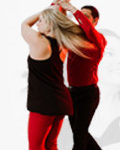Leading and following become easier, more comfortable, and more responsive once you learn to lead or follow from your body’s movement, rather than your arm. But first we need to cover an important distinction. We need to understand that connection is not a lead. If you generally want to improve your connection, read this, but if you’re ready to take it to the next level? Lets dig in!
Connection is not a Lead
Many beginning WCS dancers make the mistake of confusing connection with a lead.
At the end of every pattern, the partners should connect during the anchor by stretching away from each other. However, this connection is not yet a lead, even though the partners are pulling away from each other.
For followers, confusing connection with a lead results in rushing the anchor and getting ahead of the lead.
Leaders can also rush their anchor if they immediately try to lead the next move when they feel the follower connect into the post/anchor.
Thus, this drill is designed to build your comfort with connection, and especially with the idea of waiting until the stretch before the 1 to actually lead/follow the next pattern.
TAKE ACTION> Read – How to improve your connection
The Drill: Without a partner, stand in anchor position in front of a refrigerator.
Grasp the refrigerator door and perform an anchor triple. During the anchor, you should feel a pull from the door’s magnets as you move your center away from the door, but you should not yet be able to pull the door open.
The door should remain closed until you roll onto your heel for the last & count of the anchor.
At this point, you have hit your maximum stretch and your leverage should open the refrigerator door.
Do not pull the door open with your arm; the force to open the door should come solely from you settling your weight back.
For followers, this drill replicates the connection you feel during the anchor, as well as the need to stretch away from the connection even further during the & count prior to the 1.
For leaders, this drill simulates the feeling of your follower connecting through the anchor and then your body lead moving the follower as you roll into your 1.
Lead & Follow from the Body
Leading and following become easier, more comfortable, and more responsive once you learn to lead or follow from your body’s movement, rather than your arm.
This drill is designed to help you learn how to move your body in order to generate or feel a lead.
Struggling with practicing alone? Read this Article (w/Video)
The Drill:
For this drill, you will need both a partner and a stretchy cord, like a Theraband or a long bungee cord. You can easily purchase a band online. Ideally, the band should be long enough to wrap around the waist of both partners while in open position, although you can get by with only going around one partner.
Begin the drill by standing in open position and encircling the partners around their centers—the band should be approximately at belly-button height for both people. If the band is too short to wrap around both partners simultaneously, trade off with one person being wrapped and the other person simply holding onto their part of the band. (N.B. It is important for the partner who is holding to keep his or her arms at a constant length for this entire drill.)
The band should be the only point of connection between the partners: do not connect through the arms! The drill is for the leader to begin leading side passes, and for the follower to wait until the band pulls her before moving herself.
This drill makes it impossible for the leader to arm lead; if he tries to lead without moving his body in the direction that the follower should go, the band will simply go slack. Likewise, the follower cannot reel herself in by tightening the arm; her movement must come from her body since there is no arm connection to work off of.
Bonus Variations:
This drill can be modified to focus on additional technique elements, such as stretching through the anchor. For that exercise, the follower should pay attention to the tension in the band in order to feel the difference between a greater tension (i.e., an anchored stretch) and a lead (when the band requires her to move forward).
The drill can also be modified by using a whip pattern; there should be a body lead at both the start of the pattern as well as the 3&4 in order to create the follower’s coaster step




 Brian & Megan
Brian & Megan